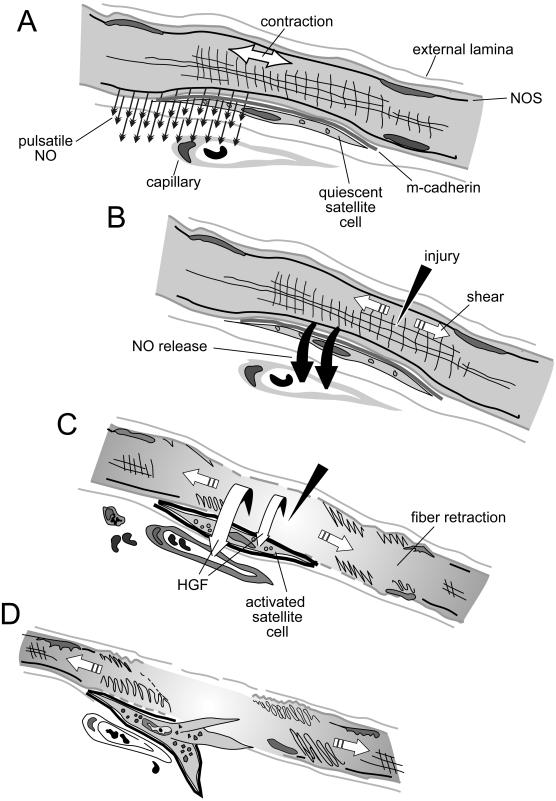Figure 8.
A model for the process of shear-induced, NO-mediated events that activate satellite cells after skeletal muscle injury. (A) In undamaged muscle with normal contraction and relaxation, thin quiescent satellite cells are demarcated by m-cadherin and contain few organelles. They are interposed between the overlying external lamina and the sarcolemma of a subjacent fiber and are subject to pulsatile NO released from NOS-Iμ that is anchored to syntrophin. Normally, NO diffuses cylindrically out from the fiber to act on cells and enzymes in the interstitium or is neutralized by red cell hemoglobin in the vessels that wrap each fiber. (B) After sarcolemmal injury, depolarization is not followed by repolarization. A single large contraction produces intense shear between the fiber membrane and the external lamina. Shear induces a bolus release of NO that diffuses down its concentration gradient through the satellite cells hugging the fiber. (C) Satellite cells become activated and begin to enlarge as organelles such as mitochondria hypertrophy. HGF/SF from the damaged fiber is activated and shifts to the c-met receptor on satellite cells. Fibrils hypercontract and damaged segments retract within the external lamina, maintaining shear and NO release and activating satellite cells along the fiber length. The adhesiveness of m-cadherin decreases, and the damaged fiber releases proteins, including HGF/SF, to the interstitium. A released factor, such as HGF/SF, enters the circulation and can transiently activate distant satellite cells on undamaged muscles, although normal pulsatile NO release will mostly attenuate that response. Capillaries dilate and blood cells extravasate into the interstitium. (D) Fiber segments fully retract and satellite cells become motile precursors as HGF/SF binds to c-met. The external lamina remains as a scaffold for the satellite cells, now surrounded by less adhesive m-cadherin. The precursors may leave the fiber as the sequential expression of early immediate genes, muscle regulatory genes, proliferating cell nuclear antigen, and later DNA synthesis begin before proliferation.

